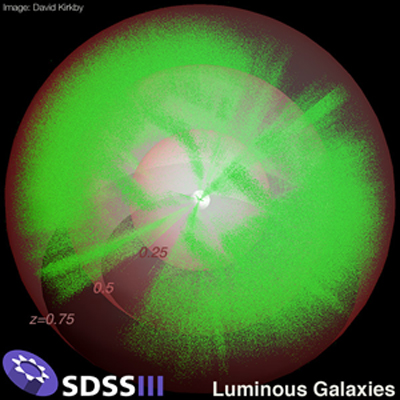Press Release: Researchers Begin To Read Largest Map of the Universe
Group Led by Carnegie Mellon’s Shirley Ho Uses SDSS-III Data To Calculate Power Spectrum of the Universe
Contact: Jocelyn Duffy / 412-268-9982 / jhduffy@andrew.cmu.edu
 AUSTIN, Texas—Researchers led by Shirley Ho, an astrophysicist at Carnegie Mellon University’s Bruce and Astrid McWilliams Center for Cosmology and the U.S. Department of Energy’s Lawrence Berkeley National Laboratory, have analyzed a trillion pixel map of the universe to create the most accurate calculation of the power spectrum of the universe over the past six billion years.
AUSTIN, Texas—Researchers led by Shirley Ho, an astrophysicist at Carnegie Mellon University’s Bruce and Astrid McWilliams Center for Cosmology and the U.S. Department of Energy’s Lawrence Berkeley National Laboratory, have analyzed a trillion pixel map of the universe to create the most accurate calculation of the power spectrum of the universe over the past six billion years.
The group’s findings were presented Jan. 11 at the annual meeting of the American Astronomical Society (AAS) in Austin, Texas, and will appear in a future issue of the Astrophysical Journal. The results are currently available at http://arxiv.org/abs/1201.2137.
Last year at the AAS meeting, researchers working on the Sloan Digital Sky Survey III (SDSS-III) unveiled the largest three-dimensional color map of the universe to date. The trillion-plus pixel image taken from the SDSS-III’s telescope at the Apache Point Observatory in New Mexico covers more than a quarter of the sky and contains more than a half billion objects, a quarter billion stars and a quarter billion galaxies.
“We have this huge map of the universe, the next step was to begin to read the map to find out what we could learn,” Ho said.
Ho and colleagues selected 900,000 luminous red galaxies from among more than 1.5 million galaxies observed through the SDSS-III’s Baryon Oscillation Spectrographic Survey (BOSS). They measured the galaxies’ brightness in five different colors; from this information the researchers were able to determine the age of the galaxies. Using the imaging data, the group then gleaned the most accurate measurement of the power spectrum of the universe — a statistical representation of how the density of matter varies throughout the universe.
“The power spectrum tells you how fast the universe is expanding, and how much dark energy, dark matter and neutrinos exist in the universe,” Ho said. “The power spectrum contains a wealth of information that could help to explain what happened at the beginning of the universe and during the expansion of the universe.”
For example, the researchers used the power spectrum to gather information about baryon acoustic oscillations (BAOs), relics of sound waves that can be used to measure dark energy in the universe. By using the new measurements, Ho and colleagues were able to precisely measure BAOs farther back in time than ever before using the colors of galaxies. They also were able to use the data to estimate that dark energy accounts for 73 percent of the density of the universe — a finding that matches estimations from other datasets.
The researchers will continue to mine the data to find more information about the universe, its expansion and contents.
###
About the Sloan Digital Sky Survey III: Funding for the SDSS-III has been provided by the Alfred P. Sloan Foundation, institutional members of the SDSS-III, the National Science Foundation and the U.S. Department of Energy Office of Science. The SDSS-III website is http://www.sdss3.org/. SDSS-III is managed by the Astrophysical Research Consortium for the Participating Institutions of the SDSS-III Collaboration including the University of Arizona, the Brazilian Participation Group, Brookhaven National Laboratory, University of Cambridge, Carnegie Mellon University, University of Florida, the French Participation Group, the German Participation Group, the Instituto de Astrofisica de Canarias, the Michigan State/Notre Dame/JINA Participation Group, Johns Hopkins University, Lawrence Berkeley National Laboratory, Max Planck Institute for Astrophysics, New Mexico State University, New York University, Ohio State University, Pennsylvania State University, University of Portsmouth, Princeton University, the Spanish Participation Group, University of Tokyo, University of Utah, Vanderbilt University, University of Virginia, University of Washington, and Yale University.
The image above shows the positions of the 900,000 luminous galaxies used in these studies. Each green dot represents one galaxy. The image covers a redshift range from 0.25 to 0.75, a time when the universe was between 7 billion and 11 billion years old.